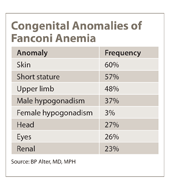Common clinical features of inherited bone marrow failure syndromes
HemOnc Today recently convened its well-respected Section Editors to present on ‘hot’ or controversial topics they deemed important to their subspecialty area. Presented here is Laurence Boxer, MD’s, discussion of topics that he believed fulfilled this qualification. HemOnc Today will continue to follow and expand coverage of these topics in the ensuing months. We hope you find these executive overviews informative.
Pediatricians and adult hematologist/oncologists have to be familiar with inherited bone marrow failure syndromes. Worth particular attention are Fanconi anemia and Dyskeratosis congenita.
|
|
Both of these disorders have common features. They include bone marrow failure associated with marrow hypoplasia leading to cytopenias, macrocytosis, aplastic anemia, myelodysplasia and/or acute myelogenous leukemia. Aplastic anemia, myelodysplasia and/or acute myelogenous leukemia may be the first hematologic presentations of these conditions. Both disorders are also associated with congenital anomalies, but in some instances, none of the common congenital anomalies may be present. In addition, both disorders predispose patients to solid tumors, which sometimes can occur in early adulthood.
The shared molecular features of Fanconi anemia and Dyskeratosis congenita include genomic instability. Specifically, in Fanconi anemia, there is an abnormality in DNA repair affecting multiple proteins that are involved in DNA repair. In Dyskeratosis congenita, the defect resides in telomere maintenance.
Fanconi anemia
The clinical features of Fanconi anemia include bone marrow failure and multiple congenital anomalies, including some that affect the skin, upper limb abnormalities including abnormalities of the thumb, male and female hypogonadism, microcephaly, and urogenital abnormalities, such as horse shoe kidney (see table). However, some patients may lack these physical abnormalities.
Other patients have a cancer predisposition, including AML, squamous cell carcinomas involving the head and neck, vagina and vulva, and brain tumors. It is important to try to elicit a family history of other affected members who may have had cancer, leukemia or aplastic anemia.
If one suspects Fanconi anemia, the diagnostic work-up includes evaluation of characteristic birth defects with hematologic abnormalities; macrocytosis in a patient with or without characteristic physical anomalies; children with aplastic anemia or myelodysplasia; patients with malignancy who are especially sensitive to chemotherapy or radiation; and nonimmune thrombocytopenia in a child.

For an internist, diagnostic suspicion should occur with the onset of cancer in patients at an early age, such as the appearance of head and neck or esophageal cancer in patients younger than age 40 years; vulvar cancer in patients younger than 30 years; and asplastic anemia in patients younger than 35 years. Family members with any of the above necessitates a thorough evaluation for Fanconi anemia.
The diagnostic test for Fanconi anemia includes a complete blood count with attention to macrocytosis and a bone marrow aspirate and biopsy to evaluate marrow cellularity.
Diagnostic testing includes chromosome breakage studies on peripheral blood lymphocytes; if a high clinical suspicion exists and the lymphocyte testing is unremarkable, then the clinician is obliged to check the skin fibroblasts for chromosome breakage. It also includes specific mutation analysis for abnormalities of one of the Fanconi genes.
Dyskeratosis congenita
Dyskeratosis congenita is another rare cause of bone marrow failure and squamous cell carcinoma. It can be inherent in an autosomal dominant, autosomal recessive or X-linked fashion. There is also a classical physical triad associated with Dyskeratosis congenita, including reticulated skin pigmentation, nail dystrophy and leukoplakia. However, in many instances the classic triad may be absent.
Other clinical features of Dyskeratosis congenita include pulmonary fibrosis, which may occur in young adults, excessive dental decay, cirrhosis, esophageal stricture, microcephaly, early hair loss or graying, epiphora, osteopenia, and development delay. Similar to Fanconi anemia, there is a predisposition to cancers including AML, early onset of squamous cell carcinoma of the head and neck, esophagus, anus and female genital tract cancers, pancreatic cancer, skin cancer and adenocarcinoma of the stomach.
The laboratory findings in Dyskeratosis congenita often include cytopenias, as well as lymphopenia, macrocytosis, elevated hemoglobin F, hypocellular bone marrow often with increased number of mast cells, dyserythropoiesis and myelopdysplasia. The most important screening test for Dyskeratosis congenita is to evaluate for short telomeres, followed by genetic testing, which may be positive in 67% of patients but not the other 33%.
The take-home message for the internist is that if a young adult is identified with head and neck cancer and bone marrow failure, the internist should be thinking of Fanconi anemia and Dyskeratosis congenita. An illustrative case is as follows: A young adult patient with non-Hodgkin’s lymphoma receives chemotherapy but remains hypoplastic on standard chemotherapy for a prolonged period of time before bone marrow recovery. Eventually, the marrow recovers and the patient successfully responds to therapy, but several years later, the patient presents with squamous cell cancer of the tongue. At that point, the internist should think of Fanconi anemia or Dyskeratosis congenita.
Laurence Boxer, MD, is the Henry and Mala Dorfman Family Professor of Pediatric Hematology/Oncology at the University of Michigan School of Medicine. He is also the school’s former director of pediatric hematology/oncology and HemOnc Today Section Editor for Pediatric Hematology and Leukocyte Disorders.

